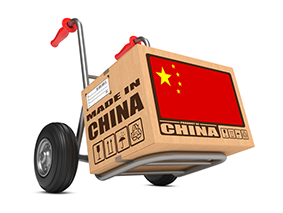 In the second quarter of 2015, China’s State Council unveiled the country’s 10-year national plan, Made in China 2025. Its purpose is to upgrade China’s manufacturing industry, with a focus on product quality, sustainability and developing domestic brands to make China a world manufacturing power. Dr Martina Gerst, Standards and Conformity Assessment Advisor at the EU SME Centre, looks at the opportunities that this initiative may present to EU SMEs.
In the second quarter of 2015, China’s State Council unveiled the country’s 10-year national plan, Made in China 2025. Its purpose is to upgrade China’s manufacturing industry, with a focus on product quality, sustainability and developing domestic brands to make China a world manufacturing power. Dr Martina Gerst, Standards and Conformity Assessment Advisor at the EU SME Centre, looks at the opportunities that this initiative may present to EU SMEs.
In addition to raising the quality of manufacturing, Made in China 2025 looks to increase productivity through digitisation and the implementation of advanced technologies, to bring it up to par with other countries. To facilitate this process, the State Council has established a fund of CNY 40 billion to push innovation, promote emerging industries, start-ups and other projects.
The plan will certainly have a global impact – Chinese manufacturing currently accounts for about 20 per cent of the world’s total[1] and ranks first worldwide in terms of output in more than 220 categories among 500 major types of industrial products.[2]
At the core of the plan are advanced ideas adopted from Germany, Japan, the United States and the UK, among others – nations that have all developed national plans to boost industrial competitiveness. It is widely seen as picking up on the concept of Germany’s Industry 4.0, an ongoing strategic initiative of the German Government that is part of the November 2011 High-Tech Strategy 2020 Action Plan. Industry 4.0 holds the potential to provide ‘end-to-end’ transparency throughout the manufacturing process, facilitating optimised decision-making in engineering processes in such a way that enables last-minute changes to production, maintaining the ability to respond flexibly to disruptions and failures. In addition, smaller suppliers may enjoy increased business opportunities through the development of smart factories that can cater to individual customer requirements where even one-off items can be manufactured profitably.
What’s in the plan?
Nine tasks have been identified as priorities that will help China to upgrade its manufacturing sector:
- Boost innovation in manufacturing.
- Promote the integration of industrialisation and IT.
- Strengthen the fundamental capacity of the industry.
- Develop quality Chinese brands.
- Enforce green manufacturing.
- Promote innovation in 10 key sectors (listed below).
- Restructure the manufacturing sector.
- Promote service-orientated manufacturing and related industries.
- Accelerate manufacturing progress through greater opening up and internationalisation.
Besides the already massively expanded research budget of more than EUR 234 billion (2012) spent in China, the plan includes five key projects for the setting-up of manufacturing innovation centres, smart manufacturing, manufacturing base strengthening, green manufacturing and high-end equipment innovation.
These priority tasks and the focus on internationalisation should result in more opportunities for European SMEs in the following sectors:
- Next generation IT
- Automated machine tools and robotics
- Aerospace and aeronautical equipment
- Maritime equipment and high-tech shipping
- Modern rail transport equipment
- Clean energy vehicles and equipment
- Power equipment
- Agricultural equipment
- New materials
- Biopharma and advanced medical products
In order to successfully realise the nine above-mentioned tasks in these strategic sectors, the plan outlines specific support and related policies that, for example, look to deepen reform mechanisms or create a fair and competitive market environment. Strengthening fiscal and taxation policies in support of SMEs is also high on the agenda.
This support for SMEs demonstrates the government’s commitment to support companies of all sizes in its push for more innovation. China’s supply-side reform stresses the government’s support to encourage sustainable business growth through tax cuts and reforms, encouraging entrepreneurship and innovation.
In Europe, a huge number of innovations are actually created by SMEs. They are the backbone of the European economy, accounting for more than 98.7 per cent of all European companies with about 92 per cent working with fewer than 10 employees.[3] A report compiled by the German Kreditanstalt für Wiederaufbau (KfW), and three European banks, concludes that investment and innovation results in strengthened competitiveness.[4]
What opportunities are there for EU SMEs?
More than 12 per cent of European SMEs are already exporting their products for manufacturing to China.[5] According to VDMA’s (Verband Deutscher Maschinen – und Anlagenbau, German Engineering Federation’s) 2012 statistics, overall exports of European machinery and equipment was about EUR 34 billion.[6]
Concrete opportunities for EU SMEs can be found in the sectors defined in the Made in China 2025 plan. For example:
- High-end equipment manufacturing
Computer Numerical Control (CNC) Systems, specialised high-end machinery, ‘productronics’, cyber-physical systems (CPS), automation, machine tools, material handling, high-end components of machinery and specialised components, rail and other transportation, and marine engineering equipment.
- Next generation IT
Core internet equipment, mobile communications, new displays, integrated circuits etc.
- New materials
New functional materials and advanced structural materials.
The EU SME Centre is already supporting SMEs in this field and briefed a delegation of Austrian experts in January on how to tackle a changing China.[7] A guide to stakeholders in the advanced materials sector can be downloaded from the Centre website at http://www.eusmecentre.org.cn/press-article/advanced-materials-china-tackling-changing-china-austrian-smes.
- Clean energy vehicles
Electric hybrid cars, electric cars, fuel cell cars, battery technology and components.
- Clean energy technology
High-efficiency and energy saving technologies; recycling waste treatment.
- Training
As the technologies listed above are all advanced, it is anticipated that services, particularly maintenance and operations, as well as vocational training, will be highly sought after in China. To ensure sustainable innovation and the transformation of China’s manufacturing sector will require a highly educated workforce with a strong emphasis on talent and skills.
Innovation
The Chinese Government is encouraging what has been previously called ‘indigenous innovation’ (part of a profound effort by the Chinese leadership to advance the country from its status as a prolific, but low-end producer to a technology leader) for Chinese local products and services. There is a great demand for technology transfer from abroad in the high-end machinery sector especially. EU SMEs could target Chinese companies with the necessary manufacturing capabilities and provide technology transfer services to them. Building such partnerships can be a good market entry strategy for EU SMEs. For more on the opportunities in China’s machinery sector, see http://www.eusmecentre.org.cn/report/machinery-sector-china.
Made in China 2025 calls for further marketisation, as well as a strengthening of intellectual property rights for SMEs, which should increase their ability to compete.
Small and medium-sized enterprises exporting their technology to China that have approached the Centre mostly perceive the major challenges to be the lack of uniformity in the regulatory framework, such as different implementation rules at the central and provincial level, and the level of protection of intellectual property (IP) that is key in the area of high-tech. To learn more about it, read the Centre’s report Exporting Goods, Services and Technology to the Chinese Market: http://www.eusmecentre.org.cn/report/exporting-goods-services-and-technology-chinese-market.
 The EU SME Centre in Beijing provides a comprehensive range of hands-on support services to European small and medium-sized enterprises (SMEs), getting them ready to do business in China.
The EU SME Centre in Beijing provides a comprehensive range of hands-on support services to European small and medium-sized enterprises (SMEs), getting them ready to do business in China.
Our team of experts provides advice and support in four areas – business development, law, standards and conformity and human resources. Collaborating with external experts worldwide, the Centre converts valuable knowledge and experience into practical business tools and services easily accessible online. From first-line advice to in-depth technical solutions, we offer services through the Knowledge Centre, the Advice Centre, the Training Centre, the SME Advocacy Platform and our Hot-Desks.
The Centre is funded by the European Union and implemented by a consortium of six partners – the China-Britain Business Council, the Benelux Chamber of Commerce, the China-Italy Chamber of Commerce, the French Chamber of Commerce in China, the EUROCHAMBRES, and the European Union Chamber of Commerce in China.
To learn more about the Centre, visit website www.eusmecentre.org.cn
[1] http://news.xinhuanet.com/english/2015-05/19/c_134252230.htm
[2] http://knowledge.ckgsb.edu.cn/2015/09/02/chinese-economy/made-in-china-2025-a-new-era-for-chinese-manufacturing/
[3] European Commission “Internationalisation of European SMEs” (2010); “EU SMEs in 2012: at the Crossroads” (2012).
[4] “SME Investment and Innovation”, France, Germany, Italy and Spain (2015) by KfW Bankengruppe (KfW).
[5] EU SME Centre website, http://www.eusmecentre.org.cn (2015).
[6] Vdma presentation; China’s machinery imports from EU 27 (2012).
[7] http://www.eusmecentre.org.cn/press-article/advanced-materials-china-tackling-changing-china-austrian-smes


Recent Comments